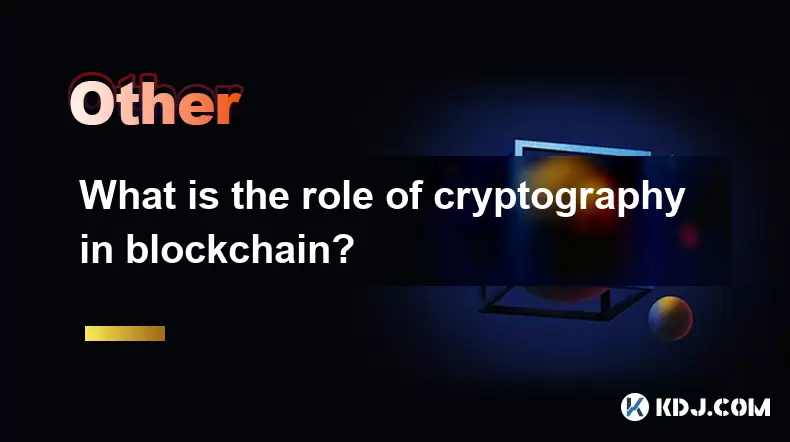-
 Bitcoin
Bitcoin $113800
0.32% -
 Ethereum
Ethereum $3477
-0.14% -
 XRP
XRP $2.873
-2.20% -
 Tether USDt
Tether USDt $0.9999
0.02% -
 BNB
BNB $749.3
-0.40% -
 Solana
Solana $161.7
-0.55% -
 USDC
USDC $0.9998
0.00% -
 TRON
TRON $0.3268
0.28% -
 Dogecoin
Dogecoin $0.1976
-0.03% -
 Cardano
Cardano $0.7250
2.27% -
 Hyperliquid
Hyperliquid $39.18
2.73% -
 Sui
Sui $3.457
1.70% -
 Stellar
Stellar $0.3832
1.16% -
 Chainlink
Chainlink $16.11
1.49% -
 Bitcoin Cash
Bitcoin Cash $539.7
1.25% -
 Hedera
Hedera $0.2410
2.21% -
 Ethena USDe
Ethena USDe $1.001
0.04% -
 Avalanche
Avalanche $21.35
0.21% -
 Toncoin
Toncoin $3.716
3.86% -
 Litecoin
Litecoin $109.3
2.88% -
 UNUS SED LEO
UNUS SED LEO $8.965
0.04% -
 Shiba Inu
Shiba Inu $0.00001214
1.02% -
 Polkadot
Polkadot $3.589
1.85% -
 Uniswap
Uniswap $9.083
1.24% -
 Monero
Monero $299.3
0.98% -
 Dai
Dai $1.000
0.02% -
 Bitget Token
Bitget Token $4.301
0.43% -
 Pepe
Pepe $0.00001045
1.32% -
 Cronos
Cronos $0.1314
0.51% -
 Aave
Aave $257.6
2.04%
What is a proxy contract in a blockchain?
Proxy contracts enable smart contract upgrades without address changes, ensuring continuity and security in blockchain apps like DeFi and gaming dApps.
Apr 14, 2025 at 04:21 pm

A proxy contract in blockchain technology is a crucial component that allows for the upgradability of smart contracts. In the world of decentralized applications (dApps) and blockchain platforms, the ability to update and modify smart contracts without disrupting the underlying system is essential. A proxy contract serves as an intermediary that delegates calls to another contract, often referred to as the "implementation" or "logic" contract. This separation of concerns enables developers to update the logic of a contract without changing its address, thereby maintaining continuity and preserving user interactions with the application.
How Proxy Contracts Work
The core functionality of a proxy contract revolves around its ability to forward calls to the implementation contract. When a user interacts with a dApp, their transactions are sent to the proxy contract, which then delegates these calls to the implementation contract. This process is transparent to the user, who remains unaware of the intermediary step. The proxy contract stores the address of the current implementation contract and can be updated to point to a new implementation if necessary.
Types of Proxy Contracts
There are several types of proxy contracts, each designed to serve specific needs within the blockchain ecosystem. The most common types include:
Transparent Proxies: These proxies are designed to be as straightforward as possible, with minimal logic beyond forwarding calls. They are typically used when the focus is on simplicity and ease of understanding.
Universal Upgradeable Proxy Standard (UUPS) Proxies: UUPS proxies allow the implementation contract to upgrade itself, providing more flexibility. This type of proxy is particularly useful for complex applications that require frequent updates.
Beacon Proxies: Beacon proxies use a separate "beacon" contract to manage the implementation address. This approach is beneficial for scenarios where multiple proxy contracts need to share the same implementation.
Benefits of Using Proxy Contracts
The use of proxy contracts offers several significant advantages to developers and users within the blockchain space. Firstly, proxy contracts enable the seamless upgrade of smart contracts without disrupting the user experience. This is crucial for fixing bugs, adding new features, or optimizing existing functionality. Secondly, proxy contracts enhance security by allowing developers to deploy and test new implementations in a controlled environment before making them live. Lastly, proxy contracts can help maintain compatibility with existing systems, as the address of the contract remains constant even after updates.
Implementation of a Proxy Contract
To implement a proxy contract, developers follow a series of steps to ensure that the proxy and implementation contracts work seamlessly together. Here is a detailed guide on how to set up a basic proxy contract:
Create the Implementation Contract: Start by writing the smart contract that contains the logic of your application. This contract will be the one that gets upgraded over time.
Deploy the Implementation Contract: Deploy the implementation contract to the blockchain network. Note the address of this contract, as it will be used in the proxy contract.
Write the Proxy Contract: The proxy contract should be designed to store the address of the implementation contract and forward any calls to it. Below is a simplified example of a proxy contract in Solidity:
// SPDX-License-Identifier: MIT
pragma solidity ^0.8.0;contract Proxy {
address public implementation;
constructor(address _implementation) {
implementation = _implementation;
}
function upgradeTo(address newImplementation) public {
implementation = newImplementation;
}
fallback() external payable {
address _impl = implementation;
assembly {
let ptr := mload(0x40)
calldatacopy(ptr, 0, calldatasize())
let result := delegatecall(gas(), _impl, ptr, calldatasize(), 0, 0)
let size := returndatasize()
returndatacopy(ptr, 0, size)
switch result
case 0 { revert(ptr, size) }
default { return(ptr, size) }
}
}
}
Deploy the Proxy Contract: Deploy the proxy contract to the blockchain, passing the address of the implementation contract as a constructor argument.
Interact with the Proxy Contract: Users and other contracts can now interact with the proxy contract, which will delegate calls to the implementation contract.
Upgrade the Implementation: When an upgrade is necessary, deploy a new implementation contract and call the
upgradeTofunction on the proxy contract to point it to the new implementation address.
Use Cases for Proxy Contracts
Proxy contracts find extensive use in various blockchain applications. One common use case is in decentralized finance (DeFi) platforms, where smart contracts need to be updated frequently to adapt to changing market conditions and to fix vulnerabilities. Another use case involves gaming dApps, where new features and improvements are regularly introduced to enhance the user experience. Additionally, proxy contracts are used in non-fungible token (NFT) platforms to manage the lifecycle of digital assets and to introduce new functionalities without disrupting existing tokens.
Potential Risks and Considerations
While proxy contracts offer significant benefits, they also come with certain risks and considerations that developers must be aware of. One major concern is the complexity introduced by the proxy pattern, which can make the system more difficult to audit and understand. Another risk is the potential for errors in the upgrade process, which could lead to unintended behavior or loss of funds. Furthermore, the reliance on proxy contracts can create a single point of failure if the proxy itself is compromised.
To mitigate these risks, developers should follow best practices such as thorough testing, regular audits, and implementing robust governance mechanisms for upgrades. It is also essential to ensure that the proxy contract is designed with security in mind, using established standards and patterns to minimize vulnerabilities.
Frequently Asked Questions
Q: Can a proxy contract be used to revert to a previous version of an implementation contract?
A: Yes, a proxy contract can be designed to allow reverting to a previous version of an implementation contract. This can be achieved by storing the addresses of all past implementations and providing a function to switch back to an earlier version. However, this approach requires careful management and governance to ensure that reverting does not introduce new issues or vulnerabilities.
Q: Are there any blockchain platforms that do not support proxy contracts?
A: Most major blockchain platforms, such as Ethereum and Binance Smart Chain, support proxy contracts. However, some platforms with more limited smart contract functionality, like Bitcoin, do not support proxy contracts due to their simpler scripting language and lack of Turing-complete smart contract capabilities.
Q: How can users verify that a proxy contract is forwarding calls correctly?
A: Users can verify the correct functioning of a proxy contract by examining the transaction logs and the contract's state on the blockchain explorer. They can check the address of the implementation contract stored in the proxy and compare it with the expected address. Additionally, users can review the proxy's source code and any available audits to ensure that the forwarding mechanism is implemented correctly.
Q: What are the costs associated with deploying and upgrading proxy contracts?
A: The costs associated with deploying and upgrading proxy contracts include gas fees for deploying the proxy and implementation contracts, as well as for executing the upgrade function. The exact costs depend on the complexity of the contracts and the blockchain network's gas prices at the time of deployment and upgrade. Developers should consider these costs when planning their upgrade strategy to minimize expenses for users.
Disclaimer:info@kdj.com
The information provided is not trading advice. kdj.com does not assume any responsibility for any investments made based on the information provided in this article. Cryptocurrencies are highly volatile and it is highly recommended that you invest with caution after thorough research!
If you believe that the content used on this website infringes your copyright, please contact us immediately (info@kdj.com) and we will delete it promptly.
- Solana's Next Chapter: SOL Prediction and the SOLF Token Buzz
- 2025-08-03 18:30:16
- Token Chart Buzz: Analysts Eye Potential Price Increase with Mutuum Finance (MUTM)
- 2025-08-03 18:30:16
- Dogecoin, Utility Tokens, and Whales: A New Era for Crypto?
- 2025-08-03 19:10:16
- Small Cap Crypto Gem Alert: Ruvi AI's 100x Potential Shakes Up Solana, Ethereum, and XRP
- 2025-08-03 19:10:16
- SOLF Token vs. BONK: Predicting a $300 Solana in 2025?
- 2025-08-03 16:30:16
- Sei, Injective, and Bitcoin Dominance: Navigating the Crypto Landscape
- 2025-08-03 16:50:15
Related knowledge

What is the difference between on-chain and off-chain transactions?
Aug 02,2025 at 04:22pm
Understanding On-Chain TransactionsOn-chain transactions refer to digital asset transfers that are recorded directly on a blockchain ledger. These tra...

What is a node's role in a blockchain network?
Aug 03,2025 at 03:16pm
Understanding the Function of a Node in a Blockchain NetworkA node is a fundamental component of any blockchain network, acting as a participant that ...

What is the double-spending problem and how does blockchain prevent it?
Aug 02,2025 at 01:07pm
Understanding the Double-Spending ProblemThe double-spending problem is a fundamental challenge in digital currency systems where the same digital tok...

What is the difference between a blockchain and a database?
Aug 01,2025 at 09:36pm
Understanding the Core Structure of a BlockchainA blockchain is a decentralized digital ledger that records data in a series of immutable blocks linke...

How does blockchain handle scalability?
Aug 02,2025 at 02:58pm
Understanding Blockchain Scalability ChallengesBlockchain scalability refers to a network's ability to handle an increasing volume of transactions wit...

What is the role of cryptography in blockchain?
Aug 03,2025 at 03:42pm
Understanding the Foundation of Blockchain SecurityCryptography is the cornerstone of blockchain technology, providing the essential tools to ensure d...

What is the difference between on-chain and off-chain transactions?
Aug 02,2025 at 04:22pm
Understanding On-Chain TransactionsOn-chain transactions refer to digital asset transfers that are recorded directly on a blockchain ledger. These tra...

What is a node's role in a blockchain network?
Aug 03,2025 at 03:16pm
Understanding the Function of a Node in a Blockchain NetworkA node is a fundamental component of any blockchain network, acting as a participant that ...

What is the double-spending problem and how does blockchain prevent it?
Aug 02,2025 at 01:07pm
Understanding the Double-Spending ProblemThe double-spending problem is a fundamental challenge in digital currency systems where the same digital tok...

What is the difference between a blockchain and a database?
Aug 01,2025 at 09:36pm
Understanding the Core Structure of a BlockchainA blockchain is a decentralized digital ledger that records data in a series of immutable blocks linke...

How does blockchain handle scalability?
Aug 02,2025 at 02:58pm
Understanding Blockchain Scalability ChallengesBlockchain scalability refers to a network's ability to handle an increasing volume of transactions wit...

What is the role of cryptography in blockchain?
Aug 03,2025 at 03:42pm
Understanding the Foundation of Blockchain SecurityCryptography is the cornerstone of blockchain technology, providing the essential tools to ensure d...
See all articles

























































































